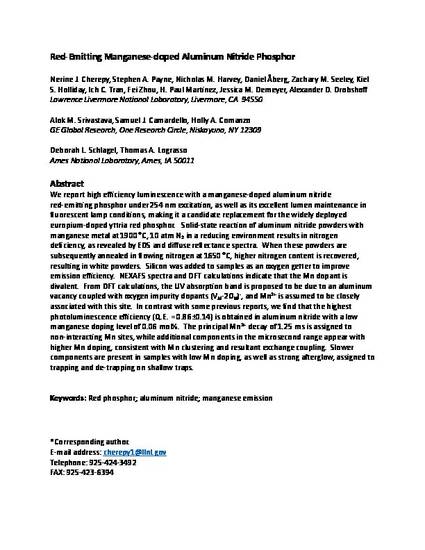
We report high efficiency luminescence with a manganese-doped aluminum nitride red-emitting phosphor under 254 nm excitation, as well as its excellent lumen maintenance in fluorescent lamp conditions, making it a candidate replacement for the widely deployed europium-doped yttria red phosphor. Solid-state reaction of aluminum nitride powders with manganese metal at 1900 °C, 10 atm N2 in a reducing environment results in nitrogen deficiency, as revealed diffuse reflectance spectra. When these powders are subsequently annealed in flowing nitrogen at 1650 °C, higher nitrogen content is recovered, resulting in white powders. Silicon was added to samples as an oxygen getter to improve emission efficiency. NEXAFS spectra and DFT calculations indicate that the Mn dopant is divalent. From DFT calculations, the UV absorption band is proposed to be due to an aluminum vacancy coupled with oxygen impurity dopants, and Mn2+ is assumed to be closely associated with this site. In contrast with some previous reports, we find that the highest quantum efficiency with 254 nm excitation (Q.E. = 0.86 ± 0.14) is obtained in aluminum nitride with a low manganese doping level of 0.06 mol.%. The principal Mn2+ decay of 1.25 ms is assigned to non-interacting Mn sites, while additional components in the microsecond range appear with higher Mn doping, consistent with Mn clustering and resultant exchange coupling. Slower components are present in samples with low Mn doping, as well as strong afterglow, assigned to trapping on shallow traps followed by detrapping and subsequent trapping on Mn.
Available at: http://works.bepress.com/d_l_schlagel/135/

This is a manuscript of an article published as Cherepy, Nerine J., Stephen A. Payne, Nicholas M. Harvey, Daniel Åberg, Zachary M. Seeley, Kiel S. Holliday, Ich C. Tran, Fei Zhou, H. Paul Martinez, Jessica M. Demeyer, Alexander D. Drobshoff, Alok M. Srivastava, Samuel J. Camardello, Holly A. Comanzo, Deborah L. Schlagel, and Thomas A. Lograsso. "Red-emitting manganese-doped aluminum nitride phosphor." Optical Materials 54 (2016): 14-21. doi: 10.1016/j.optmat.2016.02.008. Posted with permission.